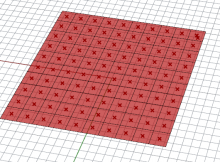A method I quickly wrote to get the centrepoint of a mesh face using the C# component in Grasshopper. More information about the mesh data structure used to generate this code is in this post.
The method essentially calculates the ‘average’ location of each of the 3 or 4 nodes on the mesh. (Formally, this is a simplification of the first moment of area.)
Point3d CentrePoint(int meshfaceindex, Mesh m) { var temppt = new Point3d(0, 0, 0); temppt.X += m.Vertices[m.Faces[meshfaceindex].A].X; temppt.Y += m.Vertices[m.Faces[meshfaceindex].A].Y; temppt.Z += m.Vertices[m.Faces[meshfaceindex].A].Z; temppt.X += m.Vertices[m.Faces[meshfaceindex].B].X; temppt.Y += m.Vertices[m.Faces[meshfaceindex].B].Y; temppt.Z += m.Vertices[m.Faces[meshfaceindex].B].Z; temppt.X += m.Vertices[m.Faces[meshfaceindex].C].X; temppt.Y += m.Vertices[m.Faces[meshfaceindex].C].Y; temppt.Z += m.Vertices[m.Faces[meshfaceindex].C].Z; if(m.Faces[meshfaceindex].IsQuad) { temppt.X += m.Vertices[m.Faces[meshfaceindex].D].X; temppt.Y += m.Vertices[m.Faces[meshfaceindex].D].Y; temppt.Z += m.Vertices[m.Faces[meshfaceindex].D].Z; temppt.X /= 4; temppt.Y /= 4; temppt.Z /= 4; } else { temppt.X /= 3; temppt.Y /= 3; temppt.Z /= 3; } return temppt; }
It’s sloppy to have the code so repetitive, but the .A and the .X notation don’t make for good code efficiency. It’s sometimes possible to use temppt[d] where d = 0, 1 or 2 for X, Y and Z correspondingly (which would allow the use of a ‘for’ loop), but the mesh Vertices property returns Point3f instead of Point3d, which doesn’t allow this.
